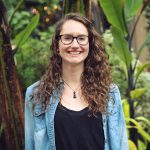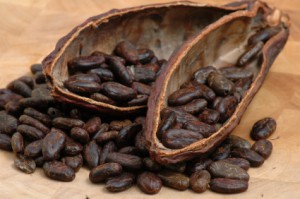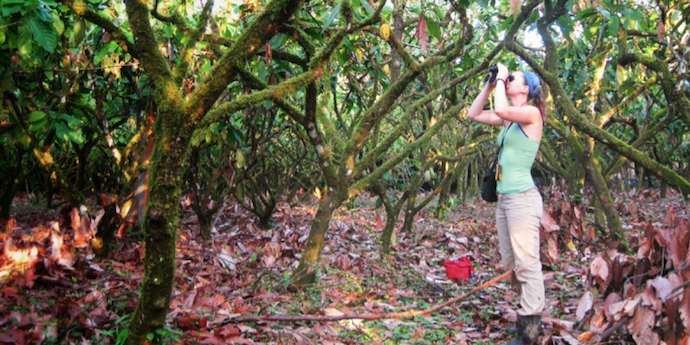The activities are as follows:
- Teacher Guide
- Student activity, Graph Type A, Level 2
- Student activity, Graph Type B, Level 2
- Student activity, Graph Type C, Level 2
- Grading Rubric
- Digital Data Nugget on DataClassroom
About 9,000 years ago humans invented agriculture as a way to grow enough food for people to eat. Today, agriculture happens all over the globe and takes up 40% of Earth’s land surface. To make space for our food, humans must clear large areas of land, which creates a drastic change, or disturbance, to the habitat. This land-clearing disturbance removes the native plants already there including trees, small flowering plants, and grasses. Many types of animals including mammals, birds, and insects depend on these native plants for food or shelter. Large scale disturbances can make it difficult to live in the area. For example, a woodpecker bird cannot live somewhere that has no trees because they live and find their food in the trees.
However, some agriculture might help some animals because they can use the crops being grown for the food and shelter they need to survive. One example is the cacao tree, which grows in the rainforests of South America. Humans use the seeds of this plant to make chocolate, so it is a very important crop! Cacao trees need very little light. They grow best in a unique habitat called the forest understory, which is composed of the shorter trees and bushes under the large trees found in rainforests. To get a lot of cacao seeds for chocolate, farmers need to have large rainforest trees above their cacao trees for shade. In many ways, cacao farms resemble a native rainforest. Many native plant species grow there and there are still taller tree species. However, these farms are different in important ways from a native rainforest. For example, there are many more short understory trees in the farm than there are in native rainforests. Also, there are fewer small flowering plants on the ground because humans that work on cacao farms trample them as they walk around the farm.
Part I: Skye is a biologist who wanted to know whether rainforest birds use the forest when they are disturbed by adding cacao farms. Skye predicted she would see many fewer birds in the cacao farms, compared to the rainforest. To measure bird abundance, she simply counted birds in each habitat. To do this she chose one rainforest and one cacao farm and set up two transects in each. Transects are parallel lines along which the measurements are taken. She spent four days counting birds along each transect, for a total of eight days in each habitat. She had to get up really early and count birds between 6:00 and 9:00 in the morning because that’s when they are most active.
Part II: Skye was shocked to see so many birds in cacao farms! She decided to take a closer look at her data. Skye wanted to know how the types of birds she saw in the cacao farms compared to the types of birds she saw in the rainforest. She predicted that cacao farms would have different types of birds than the undisturbed rainforest. She thought the bird types would differ because each habitat has different types of food available for birds to eat and different types of plants for birds to live in.
Skye broke her abundance data down to look more closely at four types of birds:
- Toucans (Eat: large insects and fruit from large trees, Live: holes in large trees)
- Hummingbirds (Eat: nectar from flowers, Live: tree branches and leaves)
- Wrens (Eat: small insects, Live: small shrubs on the forest floor)
- Flycatchers (Eat: Small insects, Live: tree branches and leaves)
Featured scientist: Skye Greenler from Colorado College and Purdue University
Flesch–Kincaid Reading Grade Level = 8.5
Additional teacher resources related to this Data Nugget:
- The research described in this activity has been published. The citation and a PDF of the scientific paper can be found here:
- Greenler, S.M. and J.J. Ebersole (2015) Bird communities in tropical agroforestry ecosystems: an underappreciated conservation resource. Agroforestry Systems 89: 691–704.
- The complete dataset for the study has been published to a data repository and is available for classroom use. This dataset has even more data than what is in the Data Nugget activity. While the Data Nugget has data for just two habitats (cacao and rainforest), the full dataset also includes two other agroforest habitat types. The dataset also includes data for every species (169) recorded during the study, whereas the Data Nugget only has data for four families (toucans, wrens, flycatchers, hummingbirds).
- Study Location: Skye’s study took place in a 10 km2 mixed rainforest, pasture, agro-forest, and monoculture landscape near the village of Pueblo Nuevo de Villa Franca de Guácimo, Limón Province, Costa Rica (10˚20˝ N, 83˚20˝ W), in the Caribbean lowlands 85 km northeast of San José.
- For more background on the importance of biodiversity, students can eat this article in The Guardian – What is biodiversity and why does it matter to us?
 About Skye: As a child Skye was always asking why; questioning the behavior, characteristics, and interactions of plants and animals around her. She spent her childhood reconstructing deer skeletons to understand how bones and joints functioned and creating endless mini-ecosystems in plastic bottles to watch how they changed over time. This love of discovery, observation, questioning, and experimentation led her to many technician jobs, independent research projects, and graduate research study at Purdue University. At Purdue she studies the factors influencing oak regeneration after ecologically based timber harvest and prescribed fire. While Skye’s primary focus is ecological research, she loves getting to leave the lab and bring science into classrooms to inspire the next generation of young scientists and encourage all students to be always asking why!
About Skye: As a child Skye was always asking why; questioning the behavior, characteristics, and interactions of plants and animals around her. She spent her childhood reconstructing deer skeletons to understand how bones and joints functioned and creating endless mini-ecosystems in plastic bottles to watch how they changed over time. This love of discovery, observation, questioning, and experimentation led her to many technician jobs, independent research projects, and graduate research study at Purdue University. At Purdue she studies the factors influencing oak regeneration after ecologically based timber harvest and prescribed fire. While Skye’s primary focus is ecological research, she loves getting to leave the lab and bring science into classrooms to inspire the next generation of young scientists and encourage all students to be always asking why!



